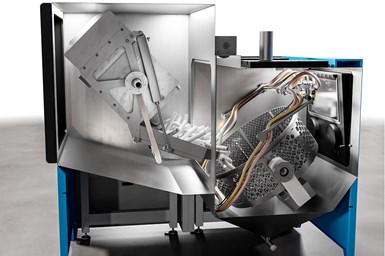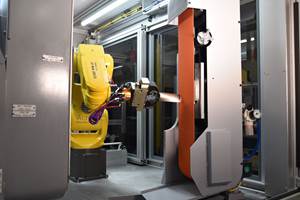Solukon Expands Compatibility of Unpacking, Cleaning Station for Plastic Parts
With adapters for EOS P 1 and P 5 series SLS manufacturing systems, the Solukon SFP770 postprocessing system can now accommodate build boxes from other leading printers, enabling Solukon to tap new markets in the area of polymer postprocessing.
Solukon has opened up new options for the postprocessing of plastic parts by adding adapters to its SFP770 unpacking and cleaning station, expanding the system’s compatibility which can now also accommodate and clean parts manufactured with EOS P 1 or P 5 systems.
“We’ve received several requests for a postprocessing system, especially for the EOS P 500,” says Andreas Hartmann, Solukon CEO and CTO. “Since the EOS P 500 is a standard plastic printer, our SFP770 postprocessing system paired with the correct adapter is now available to a much larger user base.”
Solukon introduced the SFP770 in fall 2020, presenting it as a postprocessing system for plastic parts manufactured by an EOS P 7 series printer. The system was developed after an automotive industry customer approached Solukon with a request to be able to both unpack and clean polymer components automatically, without the user coming into contact with the plastic powder. With consideration for every requirement — such as compact design and maximum flexibility — Hartmann developed what he says is the perfect system in just a few months, the SFP770.
The company says the SFP770 is a one-of-a-kind postprocessing system as it is the only one to include both an automated unpacking station and a cleaning station for SLS components in just one system. The station is compatible with EOS P 7 series systems and encompasses the 3D printer’s entire build box. With the new adapters, the SFP770 can also integrate build boxes from EOS P 1 and P 5 printers.
Automation of both the unpacking process and the transfer to the cleaning process means that the operator has almost no contact with the powder. This combination of unpacking and cleaning in one system makes “dust-free AM production” possible. The company says the automation and combination of two high-cost secondary processing steps also increases the acceptance and feasibility of industrial AM production.
The flexible programming of the postprocessing system is another great advantage. “Because so many process parameters can be programmed, the SFP770 achieves the best cleaning results, independent of build material and without manual intermediate steps,” Hartmann adds. “Our system offers another advantage — parts of varying shapes and sizes can be cleaned simultaneously, which increases the flexibility and productivity AM production.”
In addition to the cleaning process itself, Solukon’s SFP770 also optimizes the preparation of the blast material (for example, glass beads). While standard systems typically separate glass beads from plastic powder using air separators or cyclones, Solukon uses ultrasonic sieves. This is said to produce very clean glass beads, resulting in almost no losses.
Solukon sees itself well prepared for future integration of the SFP770 in fully automated manufacturing systems. “We expect plastics manufacturing to trend strongly toward a focus on postprocessing because it constitutes the decisive step in determining if something is truly manufactured in series or not,” Hartmann says. “You can optimize a manufacturing process for serial production as much as you want, but if the subsequent postprocessing fails to meet the same high standards, you will not have true serial production. At Solukon, we therefore expect to see an increased demand for automated unpacking and cleaning stations.”
- Listen to this episode of AM Radio #28 in which the AM team discusses postprocessing solutions. Follow a inserted link to watch Stephanie’s video made on the floor at Solukon’s Formnext 2021 booth.
- Read about Solukon’s SPR-Pathfinder Software for Automatic Depowdering, which is designed to calculate the ideal motion sequence for the most complex geometries, finding the best path to enable the powder to flow out completely.
- Watch the video and read the article about “Why AM Leads To Internal Production For Collins Aerospace” — using systems that include multiple Solukon depowdering machines.
Related Content
Aircraft Engine MRO: How Additive Manufacturing Plus Robotic Finishing Will Expand Capacity for Blade Repair
AM offers the chance to bring fast, automated processing to individualized, part-by-part restoration of turbomachinery. A cell developed by Acme Manufacturing and Optomec is able to automatically repair 85,000 unique aircraft engine blades per year.
Read MoreVulcanForms Is Forging a New Model for Large-Scale Production (and It's More Than 3D Printing)
The MIT spinout leverages proprietary high-power laser powder bed fusion alongside machining in the context of digitized, cost-effective and “maniacally focused” production.
Read MoreSeurat: Speed Is How AM Competes Against Machining, Casting, Forging
“We don’t ask for DFAM first,” says CEO. A new Boston-area additive manufacturing factory will deliver high-volume metal part production at unit costs beating conventional processes.
Read More3D Printed Cutting Tool for Large Transmission Part: The Cool Parts Show Bonus
A boring tool that was once 30 kg challenged the performance of the machining center using it. The replacement tool is 11.5 kg, and more efficient as well, thanks to generative design.
Read MoreRead Next
3D Printing Brings Sustainability, Accessibility to Glass Manufacturing
Australian startup Maple Glass Printing has developed a process for extruding glass into artwork, lab implements and architectural elements. Along the way, the company has also found more efficient ways of recycling this material.
Read MoreAt General Atomics, Do Unmanned Aerial Systems Reveal the Future of Aircraft Manufacturing?
The maker of the Predator and SkyGuardian remote aircraft can implement additive manufacturing more rapidly and widely than the makers of other types of planes. The role of 3D printing in current and future UAS components hints at how far AM can go to save cost and time in aircraft production and design.
Read MoreHybrid Additive Manufacturing Machine Tools Continue to Make Gains (Includes Video)
The hybrid machine tool is an idea that continues to advance. Two important developments of recent years expand the possibilities for this platform.
Read More









.png;maxWidth=300;quality=90)














